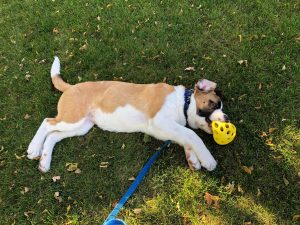DogWatch Dog Story: Mudge
Mudge the St. Bernard from Chanhassen is a DogWatch dog, but his family didn’t always work with DogWatch of the Twin Cities. With their previous dog, Mudge’s parents bought a dog fence from another company and it worked well to keep that dog in the yard. When they got Mudge, though, they decided to call us at DogWatch to help train him.
We put up boundary flags to show Mudge the boundaries of his yard and got to work. Mudge’s mom told us from the beginning: “He’s the sweetest puppy ever, but he doesn’t want to walk on the leash. He won’t try to pull you around, he’ll just lay down and not want to get back up.” And she was exactly right!
We had to get creative to train Mudge. Typically, we bring dogs around the yard on a leash over and over to help them learn where the boundary is and to stay inside the flag line. But if a huge St. Bernard doesn’t want to walk, that doesn’t quite work. Instead we focused on showing Mudge one flag at a time, we got his favorite toys involved, asked the neighbors to let their dogs out, and walked around with him off-leash (not usually recommended!).
After four days, we were happy and Mudge was happy. Finally, he was able to just take a nap in the yard. And his owners were able to trust that he wouldn’t walk off, even if they went to get the mail or went inside.
